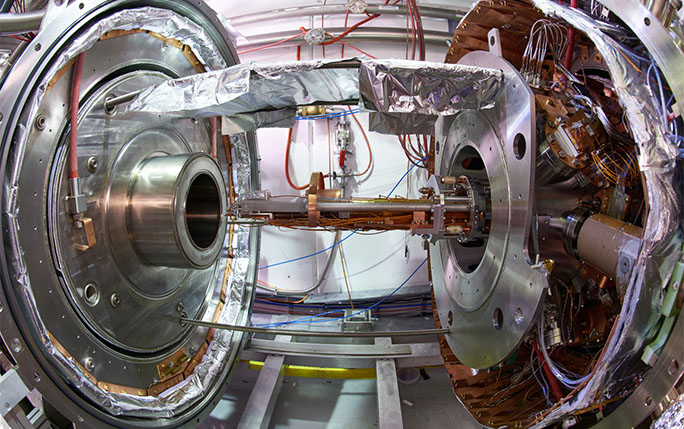AEgIS on track to test free-fall of antimatter

In a paper recently published in the journal Communications Physics, The AEgIS collaboration at CERN’s Antiproton Decelerator (AD) has reported a major milestone in its bid to measure the gravitational free-fall of antimatter – a fundamental test of the weak equivalence principle. Using a series of techniques developed in 2018, the team demonstrated the first pulsed production of antihydrogen, which allows the time at which the antiatoms are formed to be known with high accuracy. This is a key step in determining “g” for antimatter.
AVA Steering Committee member and AEgIS spokesperson Michael Doser of CERN says: “This is the first time that pulsed formation of antihydrogen has been established on timescales that open the door to simultaneous manipulation, by lasers or external fields, of the formed atoms, as well as to the possibility of applying the same method to pulsed formation of other antiprotonic atoms. Knowing the moment of antihydrogen formation is a powerful tool.”
Following a proof-of-principle measurement of g for antihydrogen by the ALPHA collaboration in 2013, ALPHA, AEgIS and a third AD experiment, GBAR, are all targeting a measurement of g at the 1% level in the coming years. In contrast to AEgIS’s approach, whereby the vertical deviation of a pulsed horizontal beam of cold antihydrogen atoms will be measured in an approximately 1 m-long flight tube, GBAR will take advantage of advances in ion-cooling techniques to measure ultraslow antihydrogen atoms as they fall from a height of 20 cm. ALPHA, meanwhile, will release antihydrogen atoms from a vertical magnetic trap and measure the distribution of annihilation positions when they hit the wall – ramping the trap down slowly so that the coldest atoms, which are most sensitive to gravity, come out last. All three experiments have recently been hooked up to the AD’s ELENA synchrotron, which enables the production of very low-energy antiprotons.
AVA fellow Mattia Fanì played a crucial role for this measurement. Being able to detect the pulse-formed antihydrogen atoms required working with a cold cloud of antiprotons: antihydrogen atoms with a velocity corresponding to a temperature of 1000 degrees would reach the (material) surface of the traps holding the antiprotons from which they are formed within one or two microseconds and annihilate. This annihilation signal comes on the heels of a much larger detector signal stemming from the injection (and partial annihilation) of positrons, as the AEgIS method requires formation of positronium atoms from positrons (which then subsequently interact with the trapped antiprotons to form antihydrogen atoms). Consequently, we also require detectors that are able to rapidly recover from the first blinding pulse. Mattia Fanì was involved in both the systematic study of novel scintillating detector materials that recover within a few 100 ns from the initial intense positron annihilation light flash, as well as in developing the plasma physics manipulations required to ensure that the antiprotons would be as cold as possible, ultimately reaching a temperature of a few 100 degrees.
Given that most of the mass of antinuclei comes from massless gluons that bind their constituent quarks, physicists think it unlikely that antimatter experiences an opposite gravitational force to matter and therefore “falls up”. Nevertheless, precise measurements of the free fall of antiatoms could reveal subtle differences that would open an important crack in current understanding.
Further information
Amsler, C., Antonello, M., Belov, A. et al. Pulsed production of antihydrogen. Commun Phys 4, 19 (2021).